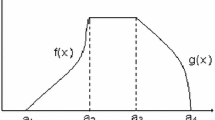Abstract
We study a two-stage, multi-item inventory system where stochastic demand occurs at stage 1, and nodes at stage 1 replenish their inventory from stage 2. Due to the complexity of stochastic inventory optimization in multi-echelon system, few analytical models and effective algorithms exist. In this paper, we establish exact stochastic optimization models by proposing a well-defined supply–demand process analysis and provide an efficient hybrid genetic algorithm (HGA) by introducing a heuristic search technique based on the tradeoff between the inventory cost and setup cost and improving the initial solution. Monte Carlo method is also introduced to simulate the actual demand and thus to approximate the long-run average cost. By numerical experiments, we compare the widely used installation policy and echelon policy and show that when variance of stochastic demand increase, echelon policy outperforms installation policy and, furthermore, the proposed heuristic search technique greatly enhances the search capacity of HGA.







Similar content being viewed by others
References
Giimiis AT, Guneri AF (2007) Multi-echelon inventory management in supply chains with uncertain demand and lead times: literature review from an operational research perspective. In: Proceedings of the institution of mechanical engineers, Part B J Eng Manuf. Professional Engineering, Publishing, London, pp 1553–1570
Clark AJ, Scarf H (2004) Optimal policies for a multi-echelon inventory problem. Manag Sci 50(12):1782–1790
Bsssler SA, Veinott AF (2006) Optimal policy for a dynamic multi-echelon inventory model. Nav Res Logist Quart 13(4):355–399
Axsater S, Rosling K (1993) Installation versus echelon stock policies for multi-level inventory control. Manag Sci 39:1274–1280
Zipkin PH (2000) Foundations of inventory management. McGraw-Hill, Boston
Roundy RO (1993) Efficient, effective lot sizing for multistage production systems. Oper Res 41:371–385
Simpson NC, Selcuk Erenguc S (2005) Modeling multiple stage manufacturing systems with generalized costs and capacity issues. Nav Res Logist 52(6):560–570
Axsater S, Zhang W-F (1999) A joint replenishment policy for multi-echelon inventory control. Int J Prod Econ 59:243–250
Iida T (2001) The infinite horizon non-stationary stochastic multi-echelon inventory problem and near-myopic policies. Eur J Opl Res 134:525–539
Jokar MRA, Seifbarghy M (2006) Cost evaluation of a two-echelon inventory system with lost sales and approximately poisson demand. Int J Prod Econ 102(2):244–254
Mohebbi E, Posner M (1998) Continuous-review inventory system with lost sales and variable leadtime. Nav Res Logist 45(3):259–278
Chiang W, Monahan GE (2005) Managing inventories in a two-echelon dual-channel supply chain. Eur J Oper Res 162(2):325–341
Gumus AT, Guneri A (2009) A multi-echelon inventory management framework for stochastic and fuzzy supply chains. Exp Syst Appl 36:5575
Wang S (1996) Neural controller for business yield management. Neural Comput Appl 4(3):183–189
Xiaobo Z, Fan F, Xiaoliang L, Jinxing X (2007) Storage-space capacitated inventory system with (r, Q) policies. Oper Res 55(5):854–865
Kevin HS, Sean XZ (2009) Optimal and heuristic echelon (r, nQ, T) policies in serial inventory systems with fixed Costs. Oper Res, in advance, pp 1–14
Hongwei W, Min G, Janet E (2004) A game-theoretical cooperative mechanism design for a two-echelon decentralized supply chain. Eur J Oper Res 157:372–388
Hongwei W, Huixin L, Jian-bo Y (2009) Dynamic analysis of a two-stage supply chain-a switched system theory approach. Int J Adv Manuf Tech 43:200–210
Yuli Z, Shiji S, Cheng W, Wenjun Y (2010) Stochastic optimization of two-stage multi-item inventory system with hybrid genetic algorithm. LSMS/ICSEE 2010 Part II, LNCS 6329. Springer-Verlag, Berlin Heidelberg, pp 484–492
Van Slyke RM, Wets Roger (1969) L-shaped linear programs with application to optimal control and stochastic programming. J Appl Math 17(4):638–663
Holland JH (1975) Adaptation in natural and artificial systems. University of Michigan Press, Ann Arbor
Zhengjun P, Lishan K, Yuping C (1998) Evolutionary computation. Tsinghua University Press, Beijing
Maiti AK, Bhunia AK, Maiti M (2006) An application of real-coded genetic algorithm (RCGA) for mixed integer non-linear programming in two-storage multi-item inventory model with discount policy. Appl Math Comput 183(2):903–915
Moon IK, Cha BC, Bae HC (2006) Hybrid genetic algorithm for group technology economic lot scheduling problem. Int J Prod Res 44(21):4551–4568
Paul RJ, Chanev TS (1997) Optimizing a complex discrete event simulation model using a genetic algorithm. Neural Comput Appl 6(4):229–237
Yuli Z, Shiji S, Cheng W, Wenjun Y (2009) Multi-echelon inventory management with uncertain demand via improved real-coded genetic algorithm. In: Proceedings of the international symposium on intelligent information systems and applications. Academy Publisher, Oulu, pp 231–236
Sven A (2000) Inventory control. Kluwer Academic Publishers, Boston
Baoding L, Ruiqing Z (1998) Stochastic programming and fuzzy programming. Tsinghua University Press, Beijing
Bertsekas DP (1999) Nonlinear programming. Athena Scientific, Belmont
Acknowledgments
The authors thank the associate editor and the two anonymous referees for their constructive comments. The paper is supported by NSFC (No. 60874071, 60834004), Project of China Ocean Association (No. DYXM-115-03-3-01), RFDP (No. 20090002110035), Independent Research Project at Tsinghua University (No. 2010THZ07002), and Distinguished Visiting Research Fellow Award of Royal Academy of Engineering of UK, UK–China Bridge in Sustainable Energy and Built Environment (EP/G042594/1), and Foundation for Academic Communication of TNList.
Author information
Authors and Affiliations
Corresponding author
Rights and permissions
About this article
Cite this article
Zhang, Y., Song, S., Zhang, H. et al. A hybrid genetic algorithm for two-stage multi-item inventory system with stochastic demand. Neural Comput & Applic 21, 1087–1098 (2012). https://doi.org/10.1007/s00521-011-0658-7
Received:
Accepted:
Published:
Issue Date:
DOI: https://doi.org/10.1007/s00521-011-0658-7




